Content
- What is IGE (total immunoglobulin), what is it responsible for in the body
- IGE norms in children and adolescents by age
- What analysis determines the level of IGE
- Indications for research
- Contraindications and restrictions
- How to prepare for the study
- How is the sampling of biomaterial
- How long to wait for research results
- Decoding analysis responses
- Reasons for deviations of indicators from the norm
- What can affect the credibility of a study?
- How to normalize IGE scores
- Video about the analysis for immunoglobulin E
IGE generic refers to a group of antibodiesthat are produced in the body. More often, doctors prescribe tests to determine its amount to children. What kind of "substance" it is, what role it plays in the body and why it is important for doctors to know its value, as well as indicators of norm and deviation, are discussed later in the article.
What is IGE (total immunoglobulin), what is it responsible for in the body
Immunoglobulin IGE was first discovered in 1960. when examining patients who have been diagnosed with blood cancer and allergies. Its amount in the blood is quite small and is approximately 0.002% of the mass of other proteins (IgA, IgM, IgG) found in the blood. Therefore, it was difficult to define "substance".
The main value of IGE is to ensure the body's response to the penetration of foreign particles (and often harmless to health). At the first penetration of the "irritant" into the body, antibodies are only produced, and the body does not react to a foreign body. With repeated contact, the body manifests a different reaction from a rash to suffocation.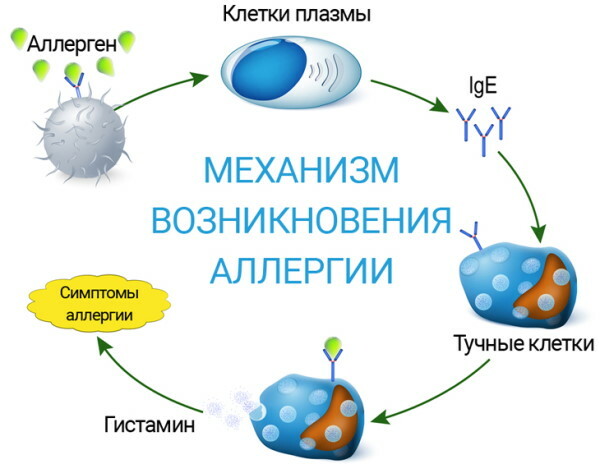
Immunoglobulin IGE is produced in the submucosa of the respiratory system, digestive tract, skin, as well as in the tonsils and sinuses. After contact with the pathogen, the "substance" triggers a chain reaction of the development of the inflammation process. As a result, the patient develops a runny nose, watery eyes, cough, or other symptoms. If a helminthic invasion enters the body, then the task of the cells is to destroy the parasite.
Bottom line. IGE is an immunoglobulin responsible for the development of an allergic reaction (the higher the value, the higher predisposition to allergies), as the amount of "substance" increases in the presence of worms in the body invasion. As a result, according to this value, doctors determine whether the patient has allergies or helminths, as well as the severity of the course of the disease.
IGE norms in children and adolescents by age
IGE general (the norm in children depends on age) allows you to timely identify a child's predisposition to an allergic reaction or the spread of helminthic invasion in the body.
The following table provides IGE data by age.
| Child's age | IGE rate (IU / ml) | Exceeding the IGE norm (IU / ml) |
| From 5 days to 1 year | Up to 15 | Above 15 |
| After 1 year to 6 years | Up to 60 | Above 60 |
| After 6 to 10 years | Up to 90 | Above 90 |
| After 10 to 16 years | Up to 200 | Above 200 |
| Over 16 years old | Up to 100 | Above 100 |
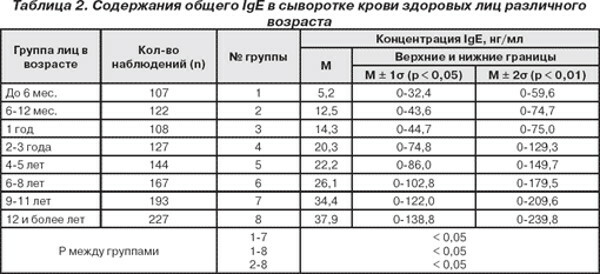 If the value is on the border, then the doctor may prescribe a re-delivery of tests in order to exclude an erroneous result.
If the value is on the border, then the doctor may prescribe a re-delivery of tests in order to exclude an erroneous result.
What analysis determines the level of IGE
To determine the amount of IGE immunoglobulin, the doctor prescribes a test, which consists in taking blood from a vein on an empty stomach (in newborns, blood is taken from the umbilical vein). The deviation of the indicator from the norm is determined by the concentration of the free "substance" in the blood serum.
Important. The sampling of biomaterial is carried out in the morning, when the concentration of immunoglobulin IGE in the blood reaches its peak.
Indications for research
IGE general (the norm in children differs from the indicators in adults) must be checked if the child has the following manifestations:
- breathing disorder similar to the onset of bronchial asthma;
- atopic dermatitis. Inflammation of the skin, accompanied by itching. Begins to develop at an early age;
- hives. Itchy rash with blisters (looks like a stinging nettle burn);
- a sharp decrease in weight. The cause may be allergies and helminthic infestations;
- loss of appetite. Allergies and worms are the cause of poisoning of the body with toxins, as a result, appetite sharply decreases;
- nausea, frequent vomiting, or diarrhea without a cause;
- prolonged bronchitis;
- Quincke's edema;
- anaphylactic shock;
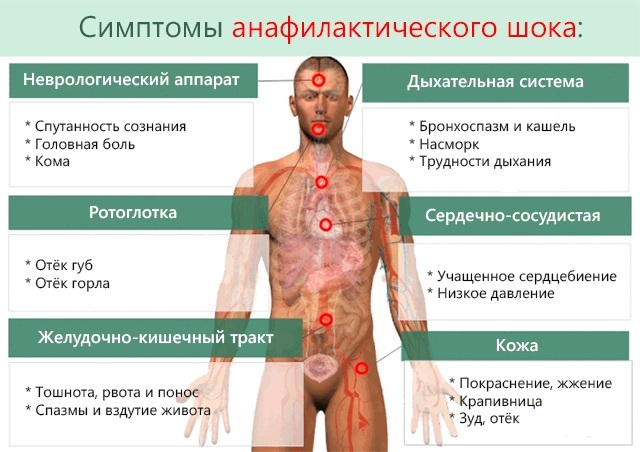
- frequent and prolonged runny nose without cold symptoms;
- sneezing, without symptoms of acute respiratory infections;
- lacrimation for no reason;
- itchy eyes;
- sleep disturbance in a child, increased irritability.
If one (or more) of the listed deviations is detected in a child, you should contact your pediatrician. Further, the doctor may refer to an allergist, immunologist or pulmonologist for a more accurate diagnosis.
Further examination will be as follows:
- determination of the child's risk group for a tendency to an allergic reaction;
- diagnosing the state of the immune system;
- identification or exclusion of the presence of helminthic invasions;
- determination of the type of allergy;
- selection of treatment tactics;
- tracking the body's response to therapy.
The course of treatment can be long, in some cases lifelong.
An increase in the value of immunoglobulin IGE is also possible with the following pathologies:
- primary immunodeficiency;
- inflammatory diseases;
- infections;
- malignant tumors.
That is why the doctor is obliged to send the child for a complete examination with an increase in the IGE indicator.
Contraindications and restrictions
The IGE immunoglobulin assay is not performed in the following cases:
- a teenage girl is having her period. The analysis is allowed to be carried out 3 days before the start of menstruation or 5 days after their end;
- the presence of an infection in a child, and the pathology is severe;
- severe exhaustion in a child. Initially, the patient needs to be stabilized;
- violation of blood coagulation;
- severe dehydration of the body. In this case, the analysis will not give an accurate result;
- undergoing antibiotic therapy. Blood sampling is possible only 10 days after the end of the course of treatment.
Also, it is impossible to take vitamin, antihistamines and blood thinning drugs to the child before passing the tests.
How to prepare for the study
The norm or deviation of the total IGE can be determined by a blood test from a vein. In order for the result to be reliable, it is necessary to properly prepare for the procedure, including when the fence is made from children.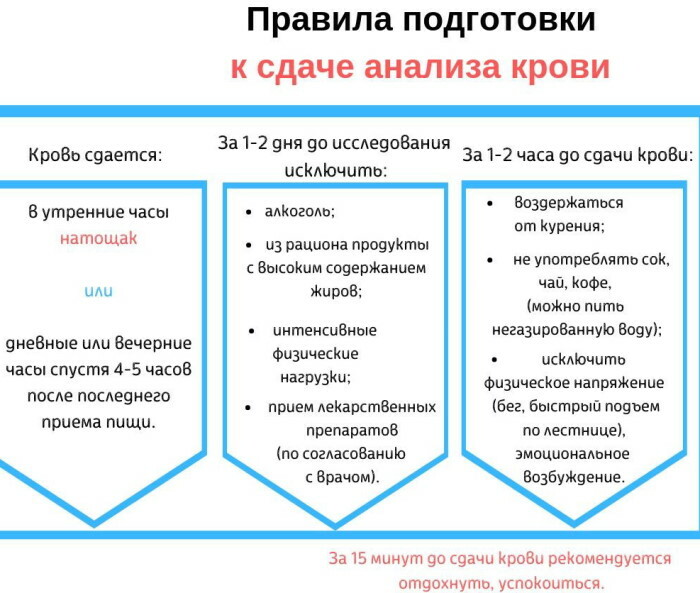
Rules for preparing for the test for immunoglobulin:
- the patient should take the last meal no later than 8 hours before blood sampling;
- on the day of donating blood, it is allowed to drink only clean water and not carbonated;
- the day before blood sampling, it is undesirable to take spicy, fatty and very salty food. For the rest, the diet cannot be changed, since then the result will not be accurate;
- you cannot smoke (information applies to adolescents), as well as take nicotine replacement drugs 2-3 hours before blood sampling;
- per day it is forbidden to take alcoholic beverages, as well as energy drinks (information for adolescents);
- physical activity is prohibited before undergoing the procedure (2-3 days before manipulations), even morning exercise;
- it is undesirable to take sun baths for 2-3 days;
- before blood sampling (about a week), you should not undergo MRI, X-ray procedures, CT and other manipulations with radiation;
- before taking blood, the patient should rest for at least 20 minutes and calm down.
Important. For the result to be accurate, the patient should not take any medications for at least 14 days.
How is the sampling of biomaterial
Blood sampling from children to determine the concentration of immunoglobulin IGE is performed in the following sequence:
- Initially, the doctor prepares the necessary instrument:
- the roller or pad on which the patient puts his hand is disinfected;
- a needle, syringe and blood collection tube are prepared. The devices must be disposable and can be opened in the presence of the patient. The doctor indicates the patient's surname on the test tube;
- a disinfectant solution and cotton wool are being prepared;
- a tourniquet is being prepared for pulling the vein.
- Further, parents (especially if the child is small) should calm and distract the young patient from the upcoming procedure.
- If the child is small, then he is seated on the knees of the parent, while the parent must clamp the child's legs between his own. If the child is more than 10 years old, then he sits on the couch on his own.
- The doctor treats his hands with a disinfectant solution and puts on medical gloves.
- The specialist determines on which hand the veins are best visible, after which he applies a tourniquet.
- Then the doctor treats the place where the needle is inserted with a disinfectant solution (usually medical alcohol).
- The doctor then opens the needle and syringe.
- Further, it is necessary that the child holds his hand with his palm up (for small children, the parents or the helping medical staff fix the hand).
- It is necessary for the child to work with his fist.
- The doctor determines the desired vein, re-disinfects the needle insertion site.
- Then the doctor inserts a needle into a vein, inserts a special syringe into the needle, removes the tourniquet and asks to unclench the child's fist.
- The required amount of blood is taken.
- After that, the doctor carefully removes the special syringe.
- Next, a cotton swab with a disinfectant solution is applied to the injection site of the needle, and only after that the needle is removed from the vein.
- Then the child needs to bend his arm at the elbow, firmly squeezing the cotton wool. If the child is very small, then the cotton wool is fixed with a bandage, which can be removed no earlier than after 20 minutes. If this point is ignored, blood may again flow from the vein or a large hematoma will form at the site of the needle insertion.
- After that, the doctor transfers the taken blood into a test tube.
- After taking a blood test, parents should sit with their child in the corridor for about 20 minutes. Since, due to stress, it is possible that the young patient will lose consciousness.
After donating blood, the child should be given a drink of sweet water or juice.
How long to wait for research results
IGE general (the norm for children is individual, depends on the state of his health) in a child can be determined in any children's clinic. 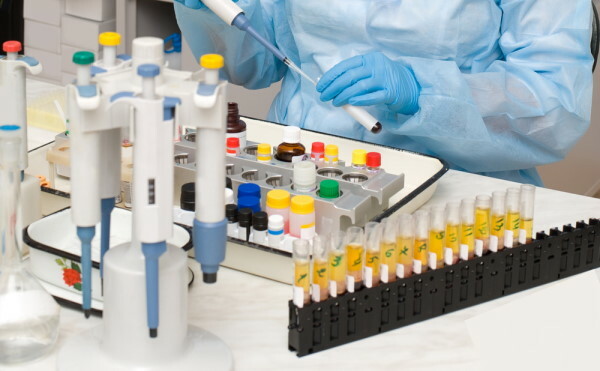 After sampling the biomaterial, the analysis results are on average ready in 3 days. In emergency cases, the doctor can shorten the time for the results to be ready.
After sampling the biomaterial, the analysis results are on average ready in 3 days. In emergency cases, the doctor can shorten the time for the results to be ready.
Decoding analysis responses
After receiving the results of the IGE immunoglobulin test, the attending specialist deals with their decoding. In this case, the indicators can be both normal and have deviations. Further, the indicators of immunoglobulin IGE are considered, depending on the alleged type of pathology.
The value of immunoglobulin IGE in different types of diseases:
| Minimum concentration IGE (ke / l) | Maximum concentration of IGE (ke / l) | Pathology type |
| 120 | 1000 | Allergic runny nose |
| 120 | 1200 | Atopic bronchial asthma |
| 80 | 14000 | Atopic dermatitis |
| 80 | 1000 | Allergic bronchopulmonary aspergillosis in remission |
| 1000 | 8000 | Allergic bronchopulmonary aspergillosis in the acute stage |
| 1000 | 14000 | Hyper-IGE syndrome |
| 15000 | Above 15000 | IGE myeloma |
Since the values of the indicators overlap, it is impossible to determine the exact type of the disease, without further examination. It is required to take into account the manifested symptoms and undergo further examination.
Important. If the immunoglobulin IGE is less than the indicated values, this is not a "good sign". Since this deviation more often signals the presence of a tumor or the transmission of other hereditary diseases.
Advice. It is recommended to take blood samples to determine the concentration of immunoglobulin IGE in the blood immediately after the onset of symptoms. Then the result of the analysis will be as reliable as possible.
Reasons for deviations of indicators from the norm
IGE general (the norm in children differs only by age, does not depend on gender) may have deviations for the following reasons: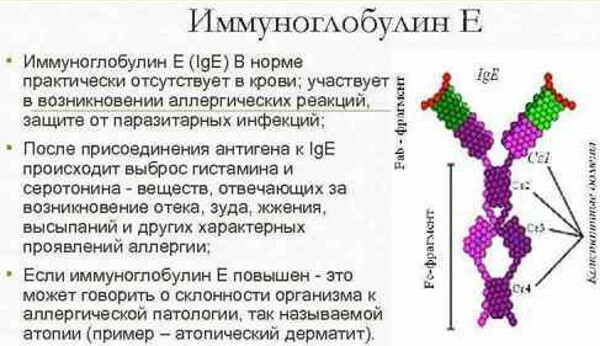
| Deviation type | List of reasons |
| Immunoglobulin IGE is higher than normal |
|
| Immunoglobulin IGE below normal |
|
If deviations in the value of immunoglobulin IGE are detected, the doctor must confirm or exclude any of the listed reasons.
What can affect the credibility of a study?
Incorrect results of the test for the concentration of immunoglobulin IGE can occur in the following cases:
- the girl was tested during menstruation;

- the child has not excluded an infectious disease;
- the patient was taking medications before testing;
- the child has breakfast or ate at night;
- fatty, salty and fried foods were not excluded from the diet, before sampling the biomaterial;
- had smoking, alcohol or energy drinks (possibly in adolescents);
- had sunbathing or a visit to the solarium;
- the child was manipulated with radiation, shortly before the procedure;
- a lot of time has passed after the symptoms of the disease;
- were heavy physical activity.
Also, the reason may be that the doctor did not properly treat the skin or used a non-sterile instrument when taking blood.
How to normalize IGE scores
An increased IGE is not a sentence, if the following recommendations are followed, it is possible to normalize indicator and keep the value for a long time:
- a woman should adhere to a healthy lifestyle and follow all the doctor's recommendations during the period of carrying a child, since even an eaten orange can cause congenital allergies;
- use hypoallergenic creams, detergents, especially for children under 3 years old;
- observe antiallergenic food;
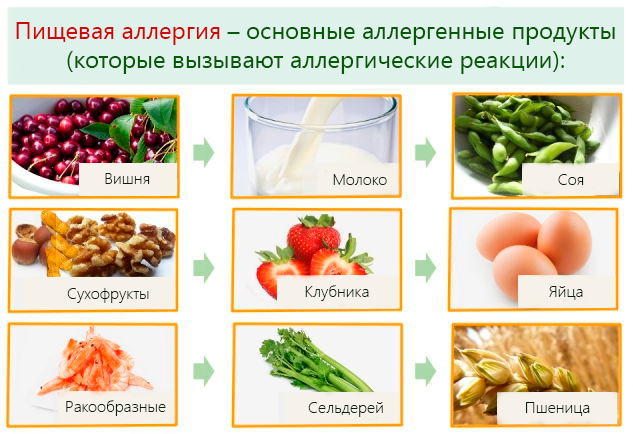
- more often to do general cleaning in the house;
- do not have pets if there is a likelihood of developing allergies;
- you can not smoke in the room where the child lives;
- daily, even in winter, ventilate the room;
- timely treat, and it is better to implement preventive measures, colds;
- if the child has seasonal allergies, give antihistamines in a timely manner;
- regularly undergo examination by a pediatrician with tests.
Also, if necessary (for example, a child has asthma), it may be necessary to move to a region with a milder climate.
IGE general allows you to diagnose in a child not only the presence of allergies, but also helminthic invasions and even timely determine the onset of tumor development. Therefore, if any of the indications listed in the article is detected in children, you should contact the pediatrician and ask for a referral for analysis. If the doctor sees a deviation from the norm, then a complete examination is required.
Author: Kotlyachkova Svetlana
Video about the analysis for immunoglobulin E
Komarovsky about immunoglobulin E:
